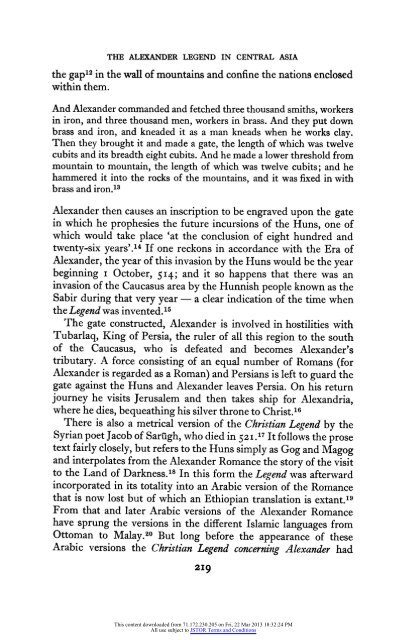The Alexander Legend in Central Asia
The Alexander Legend in Central Asia
The Alexander Legend in Central Asia
You also want an ePaper? Increase the reach of your titles
YUMPU automatically turns print PDFs into web optimized ePapers that Google loves.
THE ALEXANDER LEGEND IN CENTRAL ASIA<br />
the gapi2 <strong>in</strong> the wall of mounta<strong>in</strong>s and conf<strong>in</strong>e the nations enclosed<br />
with<strong>in</strong> them.<br />
And <strong>Alexander</strong> commanded and fetched three thousand smiths, workers<br />
<strong>in</strong> iron, and three thousand men, workers <strong>in</strong> brass. And they put down<br />
brass and iron, and kneaded it as a man kneads when he works clay.<br />
<strong>The</strong>n they brought it and made a gate, the length of which was twelve<br />
cubits and its breadth eight cubits. And he made a lower threshold from<br />
mounta<strong>in</strong> to mounta<strong>in</strong>, the length of which was twelve cubits; and he<br />
hammered it <strong>in</strong>to the rocks of the mounta<strong>in</strong>s, and it was fixed <strong>in</strong> with<br />
brass and iron.13<br />
<strong>Alexander</strong> then causes an <strong>in</strong>scription to be engraved upon the gate<br />
<strong>in</strong> which he prophesies the future <strong>in</strong>cursions of the Huns, one of<br />
which would take place 'at the conclusion of eight hundred and<br />
twenty-six years'.14 If one reckons <strong>in</strong> accordance with the Era of<br />
<strong>Alexander</strong>, the year of this <strong>in</strong>vasion by the Huns would be the year<br />
beg<strong>in</strong>n<strong>in</strong>g I October, 514; and it so happens that there was an<br />
<strong>in</strong>vasion of the Caucasus area by the Hunnish people known as the<br />
Sabir dur<strong>in</strong>g that very year - a clear <strong>in</strong>dication of the time when<br />
the <strong>Legend</strong> was <strong>in</strong>vented.15<br />
<strong>The</strong> gate constructed, <strong>Alexander</strong> is <strong>in</strong>volved <strong>in</strong> hostilities with<br />
Tubarlaq, K<strong>in</strong>g of Persia, the ruler of all this region to the south<br />
of the Caucasus, who is defeated and becomes <strong>Alexander</strong>'s<br />
tributary. A force consist<strong>in</strong>g of an equal number of Romans (for<br />
<strong>Alexander</strong> is regarded as a Roman) and Persians is left to guard the<br />
gate aga<strong>in</strong>st the Huns and <strong>Alexander</strong> leaves Persia. On his return<br />
journey he visits Jerusalem and then takes ship for Alexandria,<br />
where he dies, bequeath<strong>in</strong>g his silver throne to Christ.16<br />
<strong>The</strong>re is also a metrical version of the Christian <strong>Legend</strong> by the<br />
Syrian poet Jacob of Sartigh, who died <strong>in</strong> 521.17 It follows the prose<br />
text fairly closely, but refers to the Huns simply as Gog and Magog<br />
and <strong>in</strong>terpolates from the <strong>Alexander</strong> Romance the story of the visit<br />
to the Land of Darkness.18 In this form the <strong>Legend</strong> was afterward<br />
<strong>in</strong>corporated <strong>in</strong> its totality <strong>in</strong>to an Arabic version of the Romance<br />
that is now lost but of which an Ethiopian translation is extant.19<br />
From that and later Arabic versions of the <strong>Alexander</strong> Romance<br />
have sprung the versions <strong>in</strong> the different Islamic languages from<br />
Ottoman to Malay.20 But long before the appearance of these<br />
Arabic versions the Christian <strong>Legend</strong> concern<strong>in</strong>g <strong>Alexander</strong> had<br />
219<br />
This content downloaded from 71.172.230.205 on Fri, 22 Mar 2013 18:32:24 PM<br />
All use subject to JSTOR Terms and Conditions
















